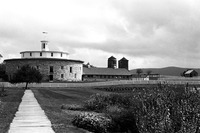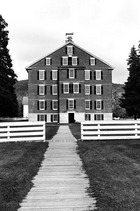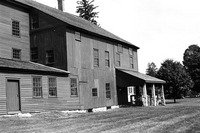With an impressive array of 20 buildings of various function, shape, and size, the Hancock Shaker Village in Pittsfield, Massachusetts is a slice of Shaker heaven -- architectural heaven that is. I have a natural affinity for antiques; I grew up in an early 1800’s colonial with an old dilapidated barn out back. Yet I think the spare, simple forms of these Shaker gems speak to those with Modernist upbringings as well. The Shakers espoused a purity of self and spirit that manifested itself in a purity of form and function, free of unnecessary ornament or complication. It’s almost as if the Shakers were early Modernists with a twist, piecing together materials like wood, stone, and brick rather than steel, reinforced concrete, and plate glass. They were industrious innovators. They created highly functional, versatile spaces, some that celebrate the building’s structure itself as in the Round Stone Barn.
heaven -- architectural heaven that is. I have a natural affinity for antiques; I grew up in an early 1800’s colonial with an old dilapidated barn out back. Yet I think the spare, simple forms of these Shaker gems speak to those with Modernist upbringings as well. The Shakers espoused a purity of self and spirit that manifested itself in a purity of form and function, free of unnecessary ornament or complication. It’s almost as if the Shakers were early Modernists with a twist, piecing together materials like wood, stone, and brick rather than steel, reinforced concrete, and plate glass. They were industrious innovators. They created highly functional, versatile spaces, some that celebrate the building’s structure itself as in the Round Stone Barn.
Perhaps the least outwardly Modern of the Hancock complex is the six-story Brick Dwelling, built in 1830 to house roughly 100 Shakers. It was modeled on an updated, pared-down neoclassical ideal, ordered and enduring. 
Brick DwellingThe interior features recognizable hallmarks of Shaker design like interior white plaster walls accented with functional peg rails, chair rails, built-ins, and baseboards all stained a rich, translucent color. You’ll also find enormous multi-paned windows and skylights that welcome natural light which was appreciated for both its physical and metaphorical attributes. Thanks to a paucity of furniture and orderly built-in storage, rooms were easily swept clean and supported a variety of functions. Furniture that was deemed necessary was built to be lightweight and easily moveable. Rooms were located according to practicality and in support of communal living.
It’s the work-buildings though that truly captivate me, and there are lots of them. The Laundry and Machine Shop of 1790 is particularly stunning. I’ve enjoyed photographing the exterior in black and white to highlight its varied wood
Laundry and Machine Shop textures and hulking mass. It’s beautiful in full color too. Nearly everything except for the roof is red: the siding, the windows, the trim. (You’ll note in the first House Enthusiast primer that I find such an exterior treatment charming and elemental.) Half the building was used by the Sisters (as they were called) to process laundry and half by the Brothers as a machine shop. In 1858 the Shakers engineered a turbine powering system in the machine shop that ran on an underground aqueduct fed by an uphill water source. There’s an impressive reproduction in the building today.
The Round Stone Barn is probably the best known of the Hancock Shaker Village buildings. It was originally built in 1826, suffered a fire in 1864, and was then partially rebuilt. At one point the barn housed the 52 milk cows that were the heart of the Shakers’ dairy farm success. The building is about 100 feet in diameter. Earthen ramps provide access to the three stories that ring an enormous central hay storage area, capped with a clerestory and towering cupola for light and ventilation. Cows occupied the first floor perimeter, and wagons the second. Manure was collected in the basement. Perhaps most impressive is the exposed, chestnut, timber-frame structure that completes the building’s circular form. It’s a geometry driven largely by practicality. Hay wagons could enter the second floor, off load down into the center haymow (as it was called), and continue around and out. Farmers could then walk around the lower level between the haymow and the perimeter stalls and easily fork hay to the cows. It’s such a simple, elegant solution to making a dairy barn.
There are plenty of other structures to explore while visiting, each representing a specific function and time period. I admire these buildings mostly because they were exquisitely purposeful, seeming to delight in their purpose. There’s nothing superfluous yet nothing that wasn’t carefully rendered. There is a big difference between this type of thoughtful, well-crafted minimalism and the often stark, empty minimalism associated with neo-Modernism. You can feel the human touch here and appreciate the clarity of simplicity. These buildings have soul. Pay them a visit; you’ll see what I mean.
by Katie Hutchison for the House Enthusiast
To visit go to www.hancockshakervillage.org

